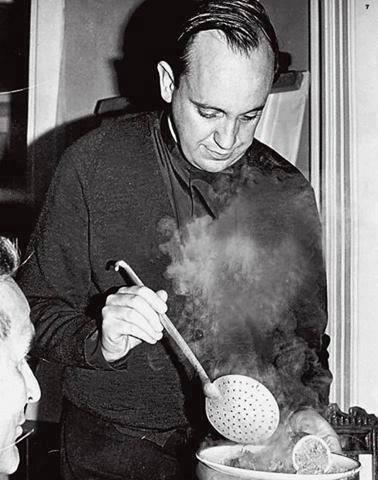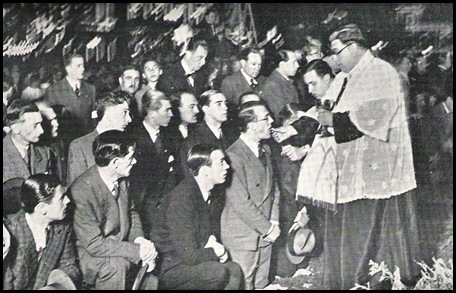SOURCE - Peace Liturgical - Letter No. 400 - August 13, 2013
In a recent letter, we did a portrait of a "country parson" the modest and remarkable Abbe Pierre Lourdelet, and we announced the next phase in the history of Opus Sacerdotale from the Council until 1988, which played an essential means for the preservation of the Catholic priesthood. Father Lourdelet asked us to withdraw our post about him and keep silent about his testimony. We removed our post about him. He nevertheless gives us leave to talk - without him - about this beautiful work that was - and remains - Opus Sacerdotale. The weight of media silence has become unbearable when it "puts it under a bushel" such lamps which we so desperately need. We return this week on a key action of this association, despite the discretion of its leaders which have always wanted to surround part of the common heritage of the Church during the Silent era.
I - DOCTRINA, FORTITUDO, PIETAS
In 1963, while the inflection taken by the Second Vatican Council began to disturb more observers, a group of French priests came together at Lourdes to wonder about the future of the priesthood. This meeting comes shortly after an "Association for the support of the Catholic priesthood," chaired by Canon Etienne Catta, of the Diocese of Nantes, Benedictine Oblate Fontgombault, former professor at the Catholic University of Angers, specialist in social doctrine and policy of the Church. Very soon, the association, known by the name Opus Sacerdotale, is given structure and developed.
Those who approached the Opus Sacerdotale originally know that its first members were parish priests and they are the ones who have both originality and success in the work. Concerned over Roman innovations, these priests who often feel isolated, seeking both to feed their personal loyalty to the dogma and to strengthen each other. It is precisely such support, both doctrinal, moral and spiritual, that is offered by Opus Sacerdotale, well illustrated in its' motto: "Doctrina, Fortitudo, Pietas."
In 1974, the death of Canon Catta (buried in the cemetery of the Abbey of Fontgombault), the Priestly Opus had nearly a thousand priests. However, the line of the organization was to do no advertising. The rigor of the canon Catta's recruitment is well known: he wanted a personal contact with every priest before they became associated with the activities of Opus. In fact, the history of Opus is little and often poorly known. But his influence and activity are important in these years which mark the height of the crisis of the priesthood in Europe.
In September 1972, for example, a delegation of fifty priests of Opus participated in a priestly brotherhood Congress in Zaragoza. Supported by the Bishop of Cuenca, Bishop Guerra Campos, the priestly Hermandad (the Priestly Fraternity), then gathered more than 5,000 Spanish priests around the defense of orthodoxy of Catholic doctrine.
Billed as an important event, the Saragossa Congress causes controversy by those which are keeping track: several Roman cardinals were planned to attend when, at the last moment, Cardinal Villot, then Secretary of State, forbade them to go there. In fact, on 14 September 1972, L'Osservatore Romano - instrument of the Secretariat of State - and the Episcopal Conference from beyond the Pyrenees (led by Cardinal Vicente Enrique y Tarancon, who regarded Bishop Guerra Campos, protector of the Hermandad as his "personal enemy") will simultaneously publish a note that Congress la Hermandad priestly Fraternity is a private initiative with neither the support of Rome or of the Spanish Church. The Archbishop of Zaragoza sends also a convoluted statement explaining that it is "without the knowledge of his own accord," as they do not say at the time, the Basilica of Our Lady of Pilar was given to delegates. Only Bishop Guerra Campos and Castan Lacoma Bishop, Bishop of Siguenza-Guadalajara, maintain their official support to the initiative, the only bishop finally this is Bishop Ángel Rodríguez Gamoneda Peruvian Vicar Apostolic Emeritus.
Despite these maneuvers the Saragossa Congress has allowed the members of Opus - whose delegation was led by Father Balastrier, monk of St. Vincent de Paul, chaplain of Our Lady of Lys in Paris editor of the canonical status of the work - to meet other European priests who, like them, are organizing to defend their best integrity of the deposit of faith. In 1973, an annual meeting of priests in Western Europe (French, German, English, Belgian, Dutch) is held at the Abbey of Vaals, Netherlands. One of the participants in this first edition told in 2005 in the journal Item headed Father Paul Aulagnier, while he was putting on his vestments, the sacristan brother told him, seeing him cross the stole: "Monsieur le Cure, you should know that no longer meets the stole because since Vatican II, it was found that the Mass is not a sacrifice." Theological shortcut striking.
Like its imposing but powerless Spanish counterpart, the Priestly Opus passed first doctrinal issues. However, Opus gladly welcomed all the priests attached to keep the Mass of their ordination. In fact, most of the "
rejected priests of the time, adhered according to the formula of Father Houghton, himself a member of Opus Sacerdotale.
II - REFLECTIONS OF PEACE LITURGICAL
1) It is important from the point of view of historical memory to remember that resistance to the new liturgical law took on , mainly in France, significant proportions, were much larger than had been imagined by Roman and Episcopal authorities.
Before the development of the Society of St. Pius X and later other traditional fraternities, there is not a diocese of France where at least some priests, sometimes more, have continued to celebrate the Tridentine Mass for the faithful , or a new mass so enriched with traditional elements (offertory use only Eucharistic Prayer 1) it was in fact a traditional mass. [1] The number of priests has never fallen for thirty years (which means it has increased significantly in relative terms, given the declining number of priests). As to the older priests were relayed by the newly ordained the Brotherhood of Archbishop Lefebvre and other traditional communities (the Priestly Opus has also helped to prepare the next generation by putting on track in the ancient convent of Moissac, which later became the Institute of Christ the King Sovereign Priest).
The very peaceful work of Canon Catta, which goes beyond the traditional priests from a strictly liturgical point of view, is to be seen in this context. In 2007, the Motu Proprio which gives parish priests the right tocelebrate the traditional Mass publicly for groups of faithful who wish, is, among other things, the consecration of forty years of resistance of parish priests.
2) When one hears preaching of Pope Francis it is sometimes said: "We understand what he says: he preaches as a parish priest of the past." His pontificate is to summarize why it would also be an attempt, in a completely different way than Benedict XVI, to restore.
Moreover, throughout his many homilies since his election, Pope Francis repeatedly called the priests to "open" their churches, their hearts and their apostolate while giving them the example of the daily Adoration of the Blessed Sacrament and inviting them to spend more time in the confessional. At the mention of such to the priests of Opus Sacerdotale, we can only say that this model of priest desired by the current Pope was still once widely present in our parishes ...
3) Finally, we also cannot forget that the Priestly Opus has materially, fraternally, spiritually supported many persecuted colleagues, or who were simply. The laity can not imagine to what isolation caused by the crisis of the Church exists, or just secularization has reduced countless diocesan priests. We bemoan today the dramatic collapse of vocations but it is not anxiety that inhabits the minds of the current diocesan seminarians at the thought of what might become of their priesthood, a fortiori when they have traditional ideas, in the provinces of France. The action of Opus Sacerdotale is also a way to provide opportunities for these future priests of Summorum Pontificum.
[1] In this context, here's what on December 23, 1974 Archbishop Lefebvre said to the seminarians Écône regarding the priests of the Opus Sacerdotale, "They say the Novus Ordo Mass, but it is approaching very close to the Mass of St. Pius V and then you have to be away from it greatly I was talking a couple of days ago with Fr Lourdelet, who took over from canon Catta in France for Opus Sacerdotale:. among these priests, they are about, I think, 600, there are certainly a hundred who still say the Mass of St. Pius V as it finally as we tell ourselves. There is a number, Fr Lourdelet himself told me he encouraged and was ready in any case to urge all members of Opus priests for them to take at least the old offertory and former canon too, and if there is a whole those priests who have decided to keep this practice as requested by Father Lourdelet, it is certain that it is still almost already the Mass of St. Pius V, one might say, especially if we keep the old offertory and the first course cannon, old canon! " (Reported in Christendom No. 90, November-December 2004). In a nutshell, the essence of what proponents advocate of what is termed "reform of the reform".










